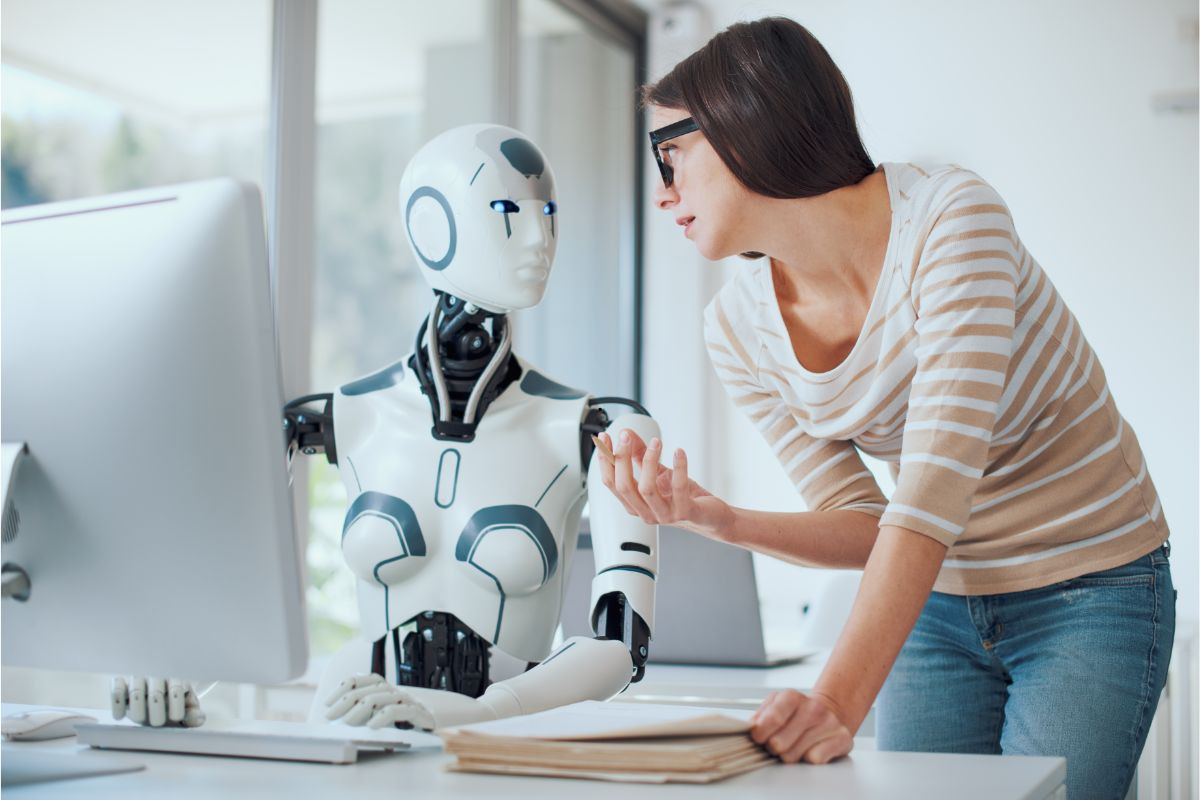7 Pros and Cons of AI in the Workplace and Education

Artificial Intelligence (AI) is transforming many industries, with the workplace and education sectors being at the forefront of this evolution. AI’s ability to analyse data, automate tasks, and enhance decision-making has brought significant changes to how we work and learn. However, like any technology, it comes with its own set of challenges. In this article, we’ll explore the pros and cons of AI in the workplace and education, helping you understand both the opportunities and the challenges that AI presents in these fields.
The Pros of AI in the Workplace
1. Increased Efficiency and Productivity
One of the most significant advantages of AI in the workplace is its ability to increase efficiency and productivity. AI systems can handle repetitive tasks, such as data entry, scheduling, and basic customer support, which frees up human workers to focus on more complex and creative tasks. This not only leads to a more streamlined workflow but also allows businesses to allocate resources more effectively.

Real-world Example
Companies like Amazon and Tesla have leveraged AI-powered robots and machines to handle logistics, reducing human error and improving the speed of operations. For example, Amazon’s warehouse robots efficiently move inventory, thereby speeding up order fulfilment times.
2. Better Decision Making with Data Analysis
AI’s ability to process and analyse vast amounts of data is another significant benefit in the workplace. AI tools can help businesses make better decisions by providing data-driven insights that humans might overlook. This is particularly useful in fields like marketing, sales, and finance, where decision-making relies heavily on data patterns and trends.
Expert Opinion
“AI systems can identify patterns that are often too complex for humans to see. This ability allows for more accurate decision-making, which is critical in industries like healthcare and finance,” says Dr. Jane Smith, AI Researcher.
3. Enhanced Customer Service
AI-powered chatbots and virtual assistants have revolutionised customer service. These tools can handle thousands of customer queries simultaneously, providing instant responses, 24/7 availability, and a personalised experience. Businesses that utilise AI in customer service can respond more quickly and efficiently, thereby enhancing customer satisfaction.
Statistical Insight
According to a 2021 report by Gartner, 70% of customer interactions are expected to involve AI chatbots by 2025, reflecting the growing role of AI in customer service.
The Cons of AI in the Workplace
1. Job Displacement Concerns
A significant downside of AI in the workplace is the potential for job displacement. As AI automates repetitive tasks, some human jobs, particularly in industries like manufacturing and retail, may become obsolete. This shift could lead to significant job losses, particularly for workers with skills that are easily automated.
Real-world Example
In manufacturing, robots have replaced assembly line workers in some factories, significantly reducing the need for manual labour. However, this has raised concerns about unemployment in specific sectors.
2. High Implementation Costs
While AI can lead to long-term savings, the initial investment required to implement AI technology can be substantial. The costs of purchasing AI systems, training employees, and maintaining the technology can be prohibitive for small and medium-sized businesses.
Expert Opinion
“AI adoption requires a significant upfront investment, which may be challenging for businesses with limited budgets. However, the return on investment can be substantial if implemented correctly,” explains Mark Thompson, Business Consultant.
3. Ethical Concerns and Bias
AI systems are only as good as the data they are trained on, and if that data is biased, the AI’s decisions can also be biased. In the workplace, this can lead to biased hiring practices, performance evaluations, and even customer interactions. Ensuring that AI systems are ethical and fair is a constant challenge for businesses.
Real-world Example
In 2018, Amazon scrapped an AI tool that was used to assist in hiring because it was found to be biased against female candidates. This highlights the importance of developing AI systems that are free from bias.
The Pros of AI in Education
1. Personalised Learning
AI in education has the potential to revolutionise personalised learning. AI-powered platforms can analyse students’ learning patterns and provide personalised lessons tailored to their strengths and weaknesses. This helps students learn at their own pace, ensuring that no one falls behind.

Real-world Example
Platforms like Duolingo use AI to personalise language learning, adjusting the difficulty of exercises based on a learner’s performance. This individualised approach has proven effective in helping students make faster progress.
2. Automated Administrative Tasks
Teachers and educators often spend a significant amount of time on administrative tasks, such as grading, scheduling, and managing student records. AI can help automate these tasks, allowing teachers to focus more on teaching and student engagement.
Statistical Insight
According to a 2020 survey by the Bill & Melinda Gates Foundation, 70% of educators agreed that AI can help reduce the time spent on administrative work, allowing more time for direct student interaction.
3. Improved Access to Education
AI can help break down barriers to education by providing online resources that are accessible to students worldwide. Virtual classrooms, AI tutors, and educational apps can make learning more inclusive, particularly for students in remote or underserved areas.
Expert Opinion
“AI-powered tools can democratize education by making high-quality resources accessible to students regardless of their geographic location or socioeconomic status,” says Sarah Lee, Education Specialist.
The Cons of AI in Education
1. Lack of Human Interaction
While AI can provide personalised learning experiences, it cannot replace the human interaction that is essential for a student’s social and emotional development. Teachers not only deliver knowledge but also play a critical role in mentoring and guiding students.
Real-world Example
Studies have shown that students who experience more face-to-face interactions with teachers perform better in terms of emotional intelligence and social skills, which AI tools cannot replicate.
2. Privacy and Data Security Concerns
AI systems in education often require access to vast amounts of student data, including personal and academic information. This raises concerns about privacy and the security of sensitive data. If not properly safeguarded, this data could be vulnerable to breaches.
Statistical Insight
A 2021 survey by the Centre for Democracy and Technology found that 60% of parents were concerned about the security of their children’s data in AI-powered educational platforms.
3. Dependence on Technology
The growing reliance on AI in education could lead to an overreliance on technology, which negatively impacts students’ critical thinking and problem-solving abilities. Additionally, technical failures or malfunctions in AI systems could disrupt learning.
Expert Opinion
“While AI is a powerful tool, it’s important to balance its use with traditional teaching methods to ensure that students don’t become overly reliant on technology,” advises Dr. Emily Johnson, Education Technologist.
Conclusion: Weighing the Benefits and Challenges of AI in the Workplace and Education
In summary, AI presents both advantages and disadvantages to the workplace and education sectors. On one hand, it offers the potential for greater efficiency, data-driven decision-making, and personalised experiences. On the other hand, it presents challenges such as job displacement, ethical concerns, and privacy risks.
As AI continues to evolve, businesses, educators, and policymakers need to find ways to mitigate its drawbacks while maximising its benefits. By doing so, we can ensure that AI serves as a tool for positive change in both the workplace and education, enhancing productivity, learning, and overall well-being.
Also Read: AI in Education: Transforming the Future of Learning
FAQs
1. How does AI improve productivity in the workplace?
AI enhances productivity by automating repetitive tasks, enabling employees to concentrate on more complex and creative work, thereby increasing overall efficiency.
2. What are the ethical concerns surrounding AI in the workplace?
AI can introduce bias into decision-making processes, such as hiring or promotions, if not properly managed and trained on unbiased data.
3. How can AI benefit personalised learning in education?
AI can tailor learning experiences to individual students by analysing their strengths and weaknesses, providing customised lessons that enhance learning outcomes.
4. What are the risks of over-dependence on AI in education?
Over-dependence on AI can reduce students’ critical thinking and problem-solving skills, as well as limit social interactions that contribute to emotional intelligence.
5. Can AI Replace Teachers in Education?
No, AI can enhance teaching by automating administrative tasks and providing personalised learning, but it cannot replace the human connection and mentorship that teachers provide.
6. What are the privacy concerns with AI in education?
AI systems in education often require access to personal student data, which raises concerns about how this data is stored and whether it is secure from breaches.
7. How can businesses mitigate job displacement due to AI?
Businesses can offer retraining and reskilling programs to help workers transition to new roles that are less likely to be automated by AI.

Similar Posts
Understanding the HBF 777 Sleep Study
Asus ROG Swift PG27UQ Gaming Monitor: A Detailed Review
Automate Your Subtitles with Flixier – The Ultimate Free Subtitle Generator